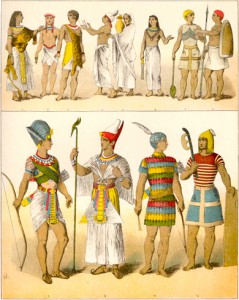A race is a notoriously hazy concept. Before a physical property can be scientifically examined, it must be objectively defined so that accurate measurement of variables can be made. The defining race is based on subjective classification, morphological interpretation, and physiognomic characteristics. A race has yet to be defined in objective genetic terms that are quantifiably measurable, rendering attempts at truly scientific discussion hopelessly futile.

The common question which has posed a concern for various historians was “What color were the ancient Egyptians?” to which the answer lies that located on the African continent; Egypt has always been an African civilization though it was overlapped by two regions, Africa and the Middle East. Hence, it is amply clear that the cultural roots of ancient Egypt lie in Africa and not in Asia.
Egypt was a subtropical desert environment and its people had migrated from various ethnic groups over its history, thus resulting in a medley of many types of people with many skin tones, some certainly from the Sub-Saharan regions and others from more Mediterranean climes. As a result of this, it is impossible to categorize those people into the usual “black” and “white” terms of today’s racial distinctions.
The Egyptians are better classified using evidence of their language and their material cultures, historical records, and their physical remains because so-called “racial” identification has been elusive, because of the reasons as cited above. In spite of this, one thing which can be stated with some certainty is that the ancient Egyptian were dark can be called as what we today as “blacks.”
It is apparent that the ancient Egyptians themselves did not make any racial distinctions but instead made rather ethnic distinctions based on nationality. Tomb paintings depicting captive Nubians may show them as being very dark, but this was an artist venting his artistic experiences and hence to conclude that the ancient Egyptians were dark would be an absurd proposition.
Paintings
From the paintings and the statuary which provide with some details with regard to the ancient Egyptian civilization, we can deduce that the ancient Egyptians were physically vigorous people, muscular, broad-shouldered, with a thin waist, full-lipped, and flat-footed from going unshod. The upper classes are represented as fashionably slender, imperiously tall, with an oval face, sloping forehead, regular features, a long, straight nose, and magnificent eyes.
Moving on to the completion of the ancient Egyptians, these people initially had somewhat of lighter or whiter complexion at the time of birth which indicates an Asiatic origin rather than an African origin but subsequently ended up getting rapidly darkened under the Egyptian sun;
From several instances, it is amply clear that that the common people and their rulers belonged from distinct races: the rulers of Asiatic, the people of African, derivation. The ancient Egyptians hair was dark, sometimes curly, though never woolly. While men shaved their lips, women bobbed their hair in the most modern mode and covered their hair with the help of magnificent wigs. It was, however, a matter of rigid etiquette that the king should have the biggest wig.
Above article tries to answer these questions: Were the ancient Egyptians black? What did ancient Egyptians look like?